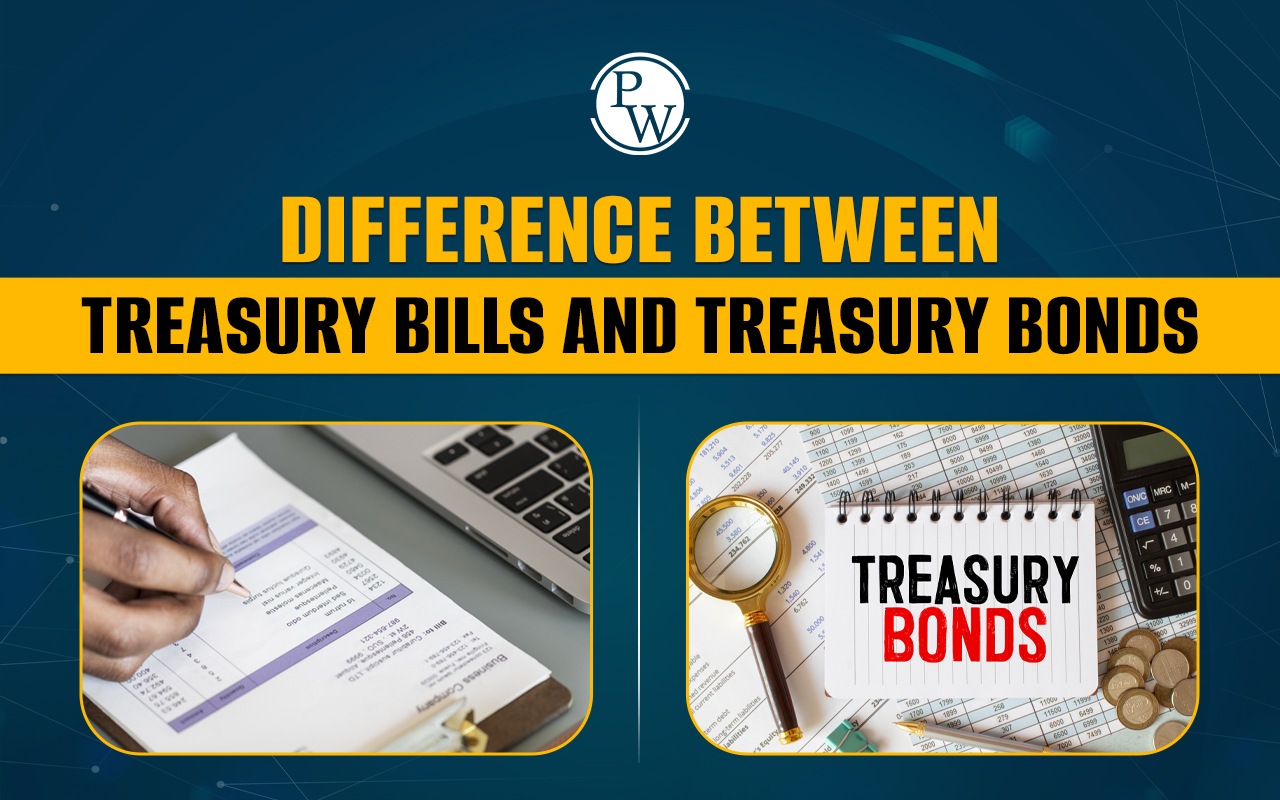

Difference Between Treasury Bills and Treasury Bonds: Treasury bills and treasury bonds are both financial instruments used by the Indian government to raise funds. Treasury bills are short-term instruments, typically used to raise money for less than a year. On the other hand, treasury bonds are long-term investments that can last for more than 10 years.
Both are considered secure investments since they are backed up by the government. However, the key difference between treasury bills and treasury bonds lies in their duration and the way they pay interest. Here, we will explain the treasury bills and treasury bonds meaning, give examples, and highlight the main differences between these two types of investments.What are Treasury Bills?
Treasury Bills refer to short-term financial instruments issued by the government to raise funds. In India, these bills are issued by the Reserve Bank of India, while in the US, they are issued by the Federal Reserve. Treasury bills are considered one of the safest investments since they are backed by the government and have no risk of default. Here are the key features of Treasury Bills (T-bills):- No Interest Payments: Treasury bills do not pay periodic interest. Instead, they are sold at a discount from their face value. Investors receive the full face value upon maturity, and the difference between the purchase price and the face value represents their return.
- Types of T-Bills: Treasury bills come in three types based on their maturity periods—91 days, 182 days, and 364 days.
- Discounted Price: They are sold at a discount and mature at their face value. The return is calculated based on this difference.
- Highly Liquid: Treasury bills are highly liquid and easily tradable in financial markets. They are often bought through mutual funds in less developed markets.
- Tax Benefits: Returns on Treasury bills are generally tax-exempt for investors.
What are Treasury Bonds?
Treasury Bonds meaning refers to long-term investment instruments issued by the government to raise funds. Treasury bonds are known for their safety as they are backed by the government and carry no risk of default. These bonds are issued with various maturities, such as 2 years, 5 years, 10 years, or even 30 years. Here are the important features of Treasury Bonds (T-Bonds):- Fixed Interest Payments: Treasury bonds pay interest to investors, typically every six months. This interest is known as a coupon payment.
- Long-Term Investment: They are long-term investments, with maturities ranging from 2 to 30 years.
- Face Value: Bonds are sold at their face value, and investors receive this amount back at maturity along with the interest payments.
- Tax Benefits: Treasury bonds are tax-exempt, meaning the interest income is not subject to federal taxes.
- Lower Risk: They are considered low-risk investments compared to corporate bonds, which have a higher risk of default.
Also Read: Monopoly Meaning
Treasury Bills and Treasury Bonds Examples
Understanding the difference between Treasury Bills and Treasury Bonds can be clarified through some practical examples. Both are government-issued securities but vary in terms of duration and payment structure. Here, check Treasury Bills and Treasury Bonds examples:Treasury Bills Example
Suppose the government issues a Treasury Bill with a face value of 20,000 INR but sells it to investors for 18,000 INR. At the end of the bill’s term, the investor will receive the full face value of 20,000 INR. The difference between the purchase price and the face value, which is 2,000 INR, represents the investor's profit.Treasury Bonds Example
Consider an investor who buys a government bond for 1,00,000 INR with a 10-year term and an annual interest rate of 5%. Every year, the investor will receive 5,000 INR in interest payments (1,00,000 INR * 5%). At the end of the 10 years, the investor will also receive the initial 1,00,000 INR back. These examples highlight the difference between Treasury Bills and Treasury Bonds. Treasury Bills are sold at a discount and pay no periodic interest, while Treasury Bonds offer regular interest payments and return the principal amount at maturity.Also Read: Class 12 Economics 2024
Treasury Bills and Treasury Bonds Differences
The difference between Treasury Bills and Treasury Bonds lies in their maturity periods, payment structures, and price fluctuations. Both are government-backed securities but serve different investment purposes. The table below highlights the key distinctions between Treasury Bills and Treasury Bonds to provide a better understanding for students:|
Difference between Treasury Bills and Treasury Bonds |
||
| Aspects | Treasury Bills (T-Bills) | Treasury Bonds (T-Bonds) |
| Meaning | Short-term financial instruments issued by the government. | Long-term financial instruments issued by the government. |
| Maturity Period | Maturity of one year or less. | The maturity period of 10 years or more. |
| Price Fluctuations | Price changes very little due to the short maturity period. | The price fluctuates more because of the longer maturity period. |
| Payment of Interest | Issued at a discounted price; no periodic interest is paid. | Pay interest twice a year and return the face value at maturity. |
| Types | 91-Day Bill, 182-Day Bill, 364-Day Bill. | Government bonds, zero-coupon bonds, municipal bonds, etc. |
| Risk | Considered very safe because they are backed by the government. | Also safe but with a longer holding period compared to T-Bills. |
| Minimum Investment | The minimum investment amount is typically Rs. 100. | The minimum investment amount is usually Rs. 1,000. |
| Returns | Provide returns by the difference between purchase price and face value. | Provide returns through regular interest payments. |
Also Check: EBIT Vs EBITDA
Therefore, understanding the differences between these two financial instruments can help investors make informed decisions based on their investment horizon and risk preferences. For short-term liquidity, T-bills are ideal, while T-bonds are better suited for those seeking a long-term, steady income stream. At Physics Wallah (PW), we strive to provide the best coaching for Commerce students, helping them build a strong foundation in finance and economics. Our experienced faculty and comprehensive courses ensure that students are well-prepared for their academic and career success. To gain a solid understanding of financial concepts and excel in your studies, join now or sign up for the PW Commerce Online Course today!| Also Read | |
| What is a Journal Entry? | Purchasing Power Parity |
| Sacrificing Ratio | Who Performs The Contract? |
| What are Subsidiary Books? | Trade Deficit |
| Reverse Repo Rate | Treatment of Goodwill |
Treasury Bills and Treasury Bonds FAQs
What is the main Difference Between Treasury Bills and Treasury Bonds?
The main difference is their duration and payment structure. Treasury Bills are short-term securities with maturities of up to one year and are sold at a discount. Treasury Bonds are long-term securities with maturities of 10 years or more and pay regular interest.
Who can buy Treasury Bills?
Individuals, firms, trusts, institutions, and banks can purchase Treasury Bills. These short-term debt instruments are issued by the Government of India with maturities of 91, 182, or 364 days.
What is the difference between bonds and government securities?
A bond is a type of government security representing a loan to the issuer. Government securities, including bonds, are financial instruments issued by the government to raise funds. Bonds specifically denote debt, while securities encompass a broader range of financial instruments.
How to calculate T-bill price?
To calculate the price of a T-bill: Price = Face Value × (1 - (Discount Rate × Time)/360). This formula adjusts the face value by the discount rate and time to determine the current price.
What are the benefits of Treasury Bonds?
Treasury Bonds offer regular interest payments, are backed by the government, and provide a predictable return on investment. They are considered low-risk and are suitable for long-term financial planning and stable incom
Talk to a counsellorHave doubts? Our support team will be happy to assist you!

Free Learning Resources
PW Books
Notes (Class 10-12)
PW Study Materials
Notes (Class 6-9)
Ncert Solutions
Govt Exams
Class 6th to 12th Online Courses
Govt Job Exams Courses
UPSC Coaching
Defence Exam Coaching
Gate Exam Coaching
Other Exams
Know about Physics Wallah
Physics Wallah is an Indian edtech platform that provides accessible & comprehensive learning experiences to students from Class 6th to postgraduate level. We also provide extensive NCERT solutions, sample paper, NEET, JEE Mains, BITSAT previous year papers & more such resources to students. Physics Wallah also caters to over 3.5 million registered students and over 78 lakh+ Youtube subscribers with 4.8 rating on its app.
We Stand Out because
We provide students with intensive courses with India’s qualified & experienced faculties & mentors. PW strives to make the learning experience comprehensive and accessible for students of all sections of society. We believe in empowering every single student who couldn't dream of a good career in engineering and medical field earlier.
Our Key Focus Areas
Physics Wallah's main focus is to make the learning experience as economical as possible for all students. With our affordable courses like Lakshya, Udaan and Arjuna and many others, we have been able to provide a platform for lakhs of aspirants. From providing Chemistry, Maths, Physics formula to giving e-books of eminent authors like RD Sharma, RS Aggarwal and Lakhmir Singh, PW focuses on every single student's need for preparation.
What Makes Us Different
Physics Wallah strives to develop a comprehensive pedagogical structure for students, where they get a state-of-the-art learning experience with study material and resources. Apart from catering students preparing for JEE Mains and NEET, PW also provides study material for each state board like Uttar Pradesh, Bihar, and others
Copyright © 2025 Physicswallah Limited All rights reserved.











